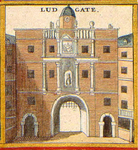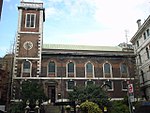St Ann Blackfriars
1666 disestablishments in England16th-century Church of England church buildingsBuildings and structures demolished in the 17th centuryChurches destroyed in the Great Fire of London and not rebuiltChurches in the City of London ... and 2 more
Dominican churches in the United KingdomFormer buildings and structures in the City of London

St Ann Blackfriars was a church in the City of London, in what is now Ireland Yard in the ward of Farringdon Within. The church began as a medieval parish chapel, dedicated to St Ann, within the church of the Dominicans (the order after whom the Blackfriars district of London is named). The new parish church was established in the 16th century to serve the inhabitants of the precincts of the former Dominican monastery, following its dissolution under King Henry VIII. It was near the Blackfriars Theatre, a fact which displeased its congregation. It was destroyed in the Great Fire of London of 1666.
Excerpt from the Wikipedia article St Ann Blackfriars (License: CC BY-SA 3.0, Authors, Images).St Ann Blackfriars
Carter Lane, City of London
Geographical coordinates (GPS) Address Nearby Places Show on map
Geographical coordinates (GPS)
| Latitude | Longitude |
|---|---|
| N 51.513183333333 ° | E -0.10239166666667 ° |
Address
Carter Lane 77
EC4V 5EA City of London
England, United Kingdom
Open on Google Maps








